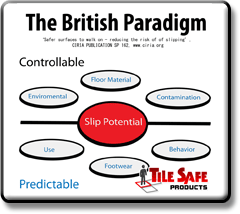|

What's the best way to prevent slips and falls? Based on the number
of injuries in the workplace due to slippery floor conditions, there
is no simple answer.
A slip and fall occurs whenever there is too little friction or
traction between your feet and the surface you are walking on.
While the major cause of slip and falls is surface contamination
that reduces the contact between the feet and the floor surface,
there are several other factors that also contribute to slip falls
like the environment, footwear, floor material, use of surface,
behaviour. Some of the contaminants can be water, oil, dust and
anything that reduces the traction and make the floor surface
slippery.
No single solution, any one solution -- be it slip-resistant shoes,
micro etching, mats, proper cleaning practices or worker awareness
-- will not eliminate the hazard. OH&S professionals who want to
implement, upgrade or review their slip-prevention programs need to
ensure that they consider all aspects of what causes a slip and what
can be done to reduce or eliminate one of the workplace's most
common hazards.
Malcolm C. Robbins, a forensic engineer in San Diego who studies
slip-and-fall accidents, said that unless someone can design a 100
percent slip-resistant environment and plan for the worst condition
possible, the hazard cannot be eliminated. "If you say something
is 90 percent effective, that still leaves 10 percent for an
accident."
|
|

Evaluation of Risk using Qualitative
Risk Assessment
- Evaluate risk in terms
of likelihood and consequences
- Review available
information
- Identify treatments to
control risk
- Document records to
ensure risks are controlled
We can predict the Use of
the surface, type of Footwear will be used on the
surface and Behaviour of people and equipments using the
floor surface and can develop Environmental, Floor
Surface Material and Contamination controls as well as
guide on suitable Footwear and educate Behaviour.
- Environment:
adequate lighting, covering exposed areas, slopes or
gradients, etc)
- Floor Surface
Materials: employing non-slip
surfaces and/or applying remedial non slip treatments to
reduce/eliminate likelihood of slip falls. Please note
that you also want to consider some other aspects like
clean ability of the surface, trip hazard, product
suitability and effectiveness, maintenance, esthetical
appearance, etc,. of any of the solutions,
These slip fall prevention measures can be:
-
Good housekeeping
-
Mats at entry foyers
|
-
Chemical micro etching
-
Grinding
|
|
|
-
Contamination: develop and
implement Contaminated Floor Prevention policies,
creating and maintaining a Floor Safety / Slip
Resistance Register
|
|
|

While any slip-prevention
program should include several elements, slip-resistant footwear is
a key to making the program work. To make sure that a shoe is truly
slip-resistant, ask the manufacturer for test results that should
come from an independent lab to ensure that results are valid.
The two factors to achieving slip resistance with a shoe: the rubber
compound and the tread pattern design, including the tread's
surface-to-void ratio. The rubber compound needs to be soft enough
to provide slip resistance but hard enough to last and maintain its
tread pattern after contact with floor surfaces and contaminants.
The tread pattern design should have a grid pattern that channels
water, grease and other residues away from the bottom of the shoe.
Behaviour: Create Employee Awareness by encouraging and
rewarding those who practice safe working habits and maintain a
clean work environment. Workers can reduce the risk of slipping by:
-
Taking their time and paying attention to where they are going;
-
Adjusting their stride to a pace that is suitable for the
walking surface and tasks being performed;
-
Walking with feet pointed slightly outward;
-
Making wide turns at corners; and
-
Ensuring that items being carried or pushed do not prevent them
from seeing spills.
-
Include employees in all phases of a slip-prevention program.
"They're going to know best about the work areas, hazards and
solutions."
For further information regarding to
the development of the Floor Safety/Slip Resistance challenge you
may have, click on Enquiry and provide us with your details and
specific concern and your nearest Safety representative will contact
you.
|
|

NO
MORE SLIPPERY FLOORS, BENEFITS OF ANTI SLIP FLOORING
-
It will save money for you by reducing the likelihood of slip
and fall accidents and litigation at your work place and public
places. At the home prevents a serious slip injury to loved ones
on slippery floor.
-
Assist managers, owners, employers with compliance with relevant
Workers Compensation/OH&S and other floor safety regulations,
standards and acts.
-
An Anti-Slip/non slip floor surface will ensure that all of your
staff, visitors and clients will have a safe and happy
environment, increases productivity.
-
For Commercial clients it is not only guaranteed for up to 3
years but during that period of time you also will have our
floor safety risk management program supplied, at NO Additional
Cost to You!
-
For Domestic clients – your home or residential investment
properties - we guarantee the Anti-Slip surface for life! (Some
conditions apply)
-
Minimum or no disruption to your business / home during
application.
-
Our Anti-Slip surface solutions are suitable for most work
areas, including your office, entrances, factory floors, stairs,
ferry docks, walking paths, workshops, canteens, restaurants,
clubs, kitchens, bathrooms, change rooms, and car parks for
interior or exterior areas as well. We can even make inside your
swimming pools and the steps Anti-Slip. We have the solution not
only for all of your slippery tiled surfaces, but for concrete,
vinyl, wood, rubber, metallic and acrylic areas as well.
-
When you are dealing with your local Floor Safety
Representative, you are actually dealing with not a single
person or company, but a member of the Global Safety Surfaces
Network, which spans across continents and growing on a daily
basis.
This is only just the
beginning of our service and at all times you can be sure that
our representative will have your best interest at heart.
|
|

 |
If Safety Hazards in the Workplace Are Not Addressed:
▪ Every person directing work in
the workplace can be held
legally liable for accidents
resulting from unsafe working
conditions.
In the Event of
an Accident:
▪ Company decision-makers
can go to jail.
▪ Organizations can be more
heavily fined
To Protect Yourself from
Legal Liability:
• Be aware of any safety
hazards in your workplace.
• Immediately take steps to
solve the problem.
• If risks cannot be eliminated
consultation is required with
relevant stakeholders.
|
|
 |
|
 Safe TileMicro Etching Anti-Slip Solution. Increase traction by creating microscopic channels in most hard mineral surfaces.
Safe TileMicro Etching Anti-Slip Solution. Increase traction by creating microscopic channels in most hard mineral surfaces. WearMaxWaterborne, low VOC, clear anti-slip protective coating system.
WearMaxWaterborne, low VOC, clear anti-slip protective coating system. Multi KleenExtra heavy duty water soluble, green, anti-bacterial, multi–purpose cleaner.
Multi KleenExtra heavy duty water soluble, green, anti-bacterial, multi–purpose cleaner. Safe GripCold vulcanized anti-slip & anti-skid treatment solution. Very fast drying and curing state of the art highly non slip product.
Safe GripCold vulcanized anti-slip & anti-skid treatment solution. Very fast drying and curing state of the art highly non slip product. 










